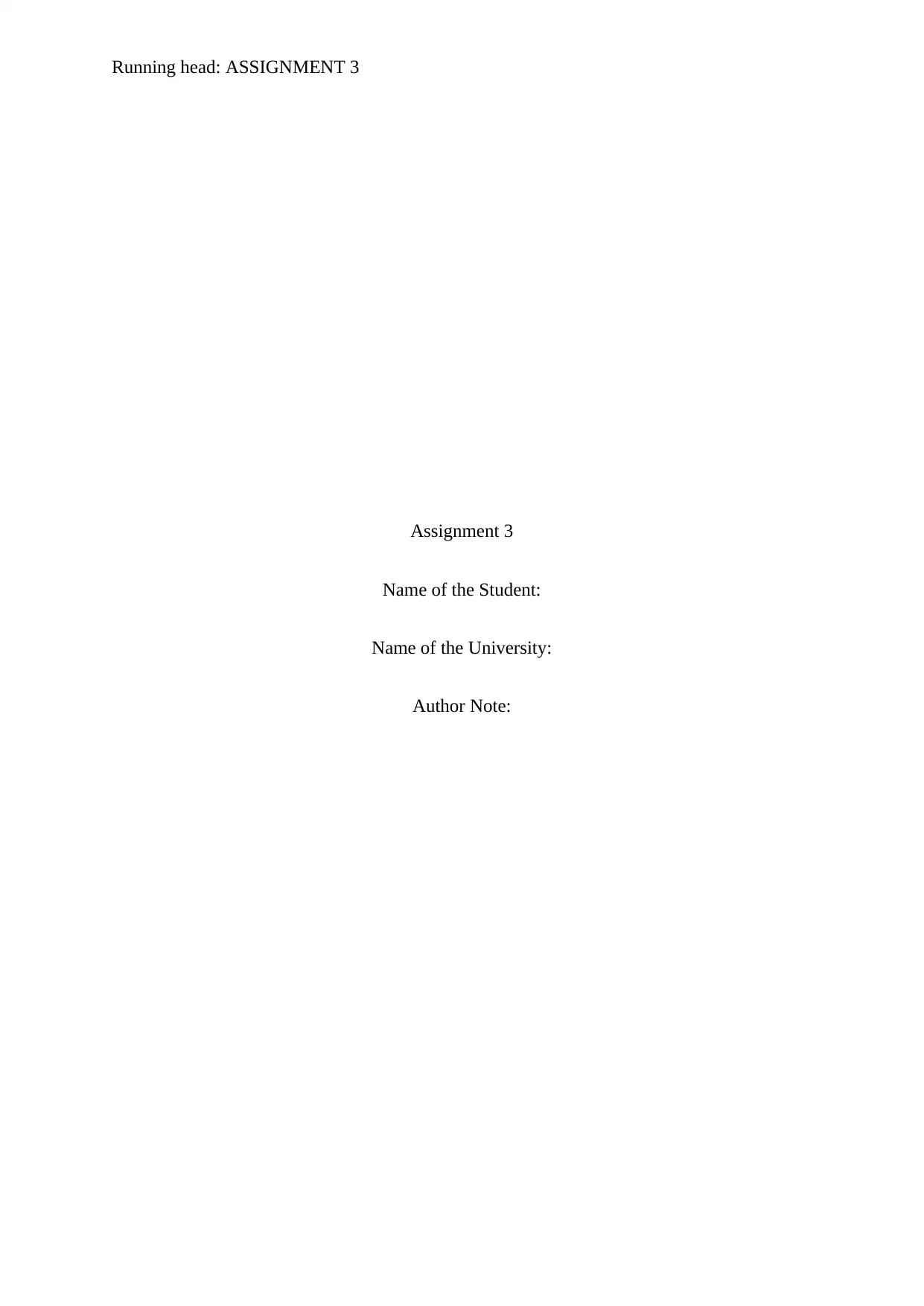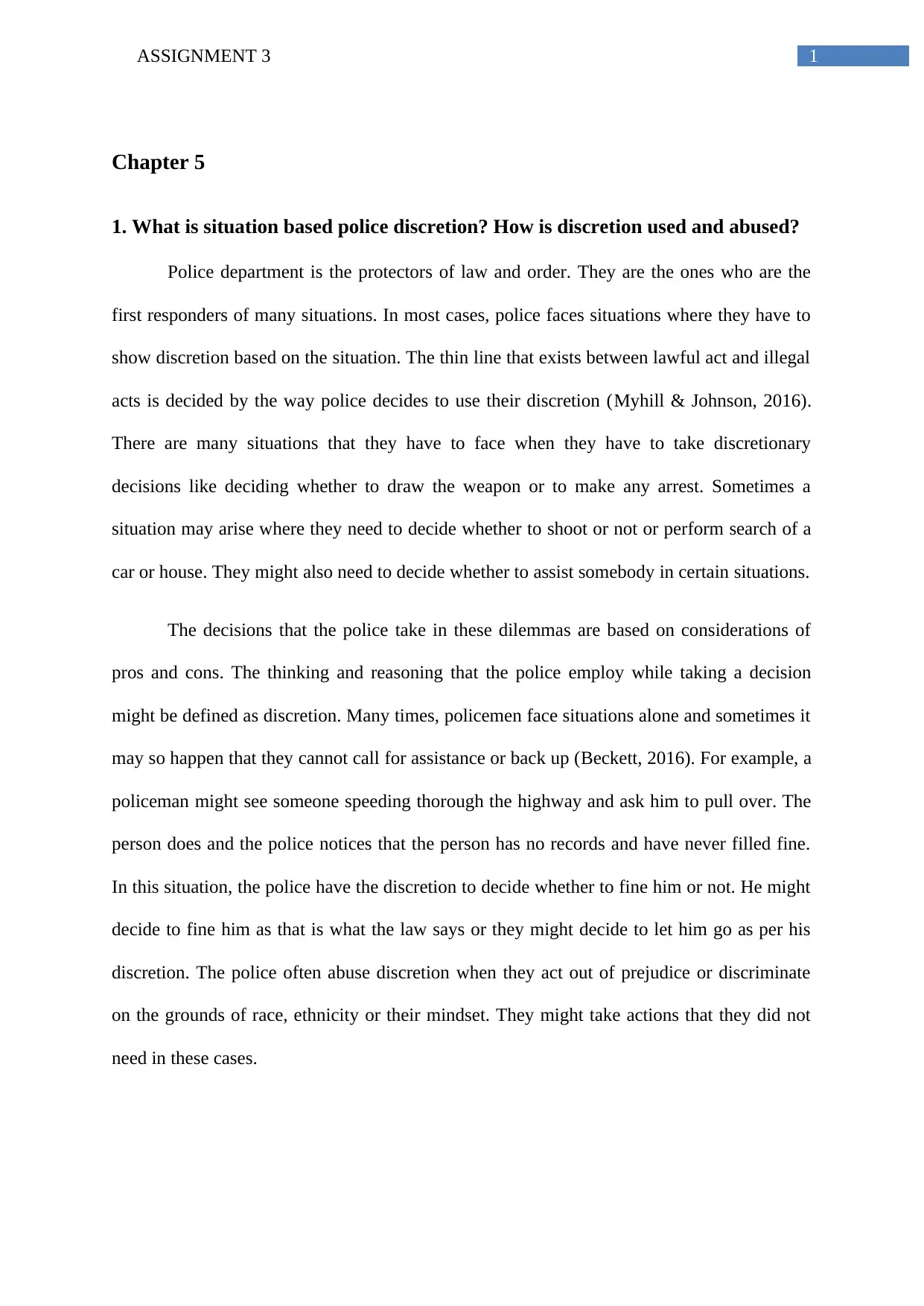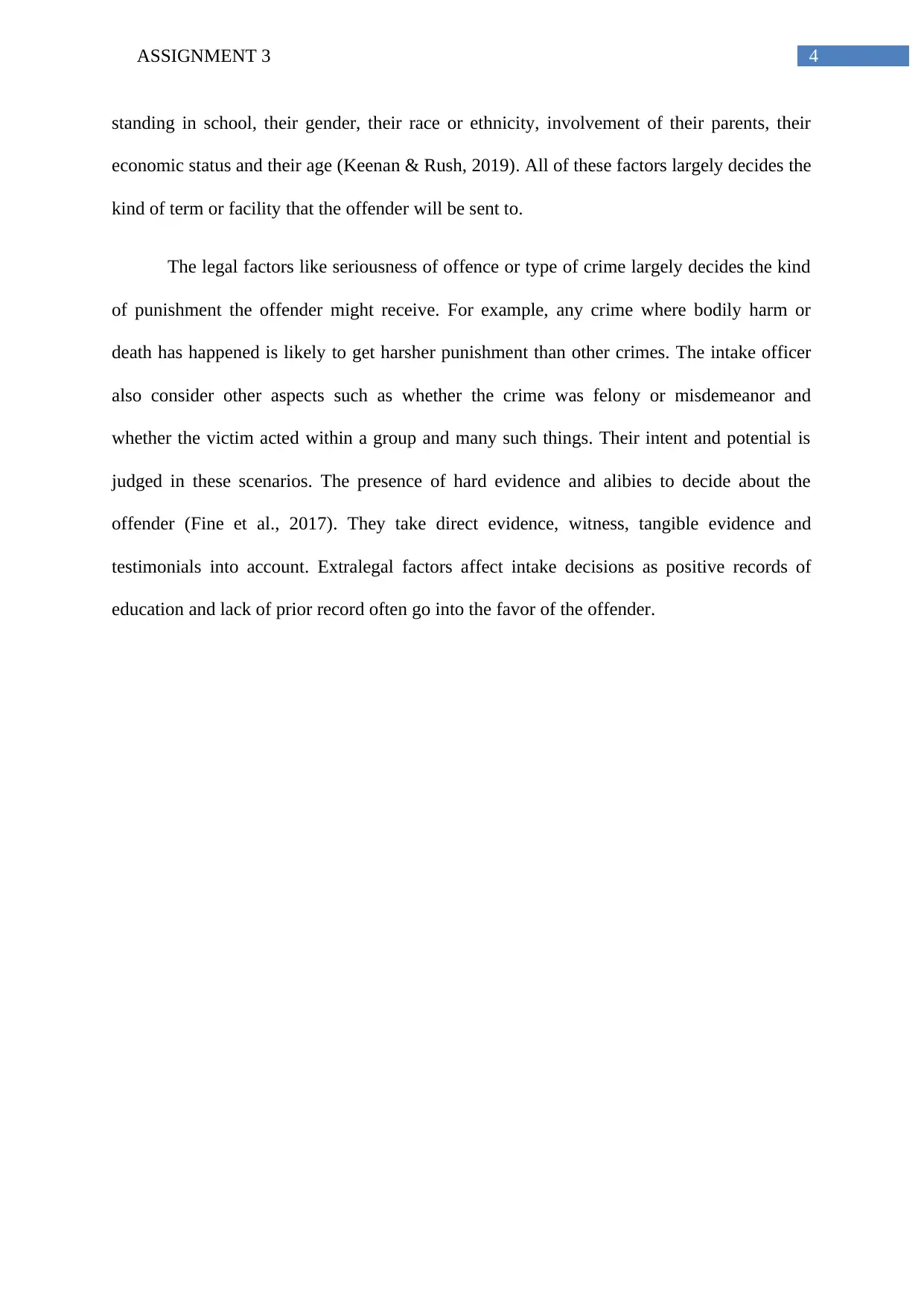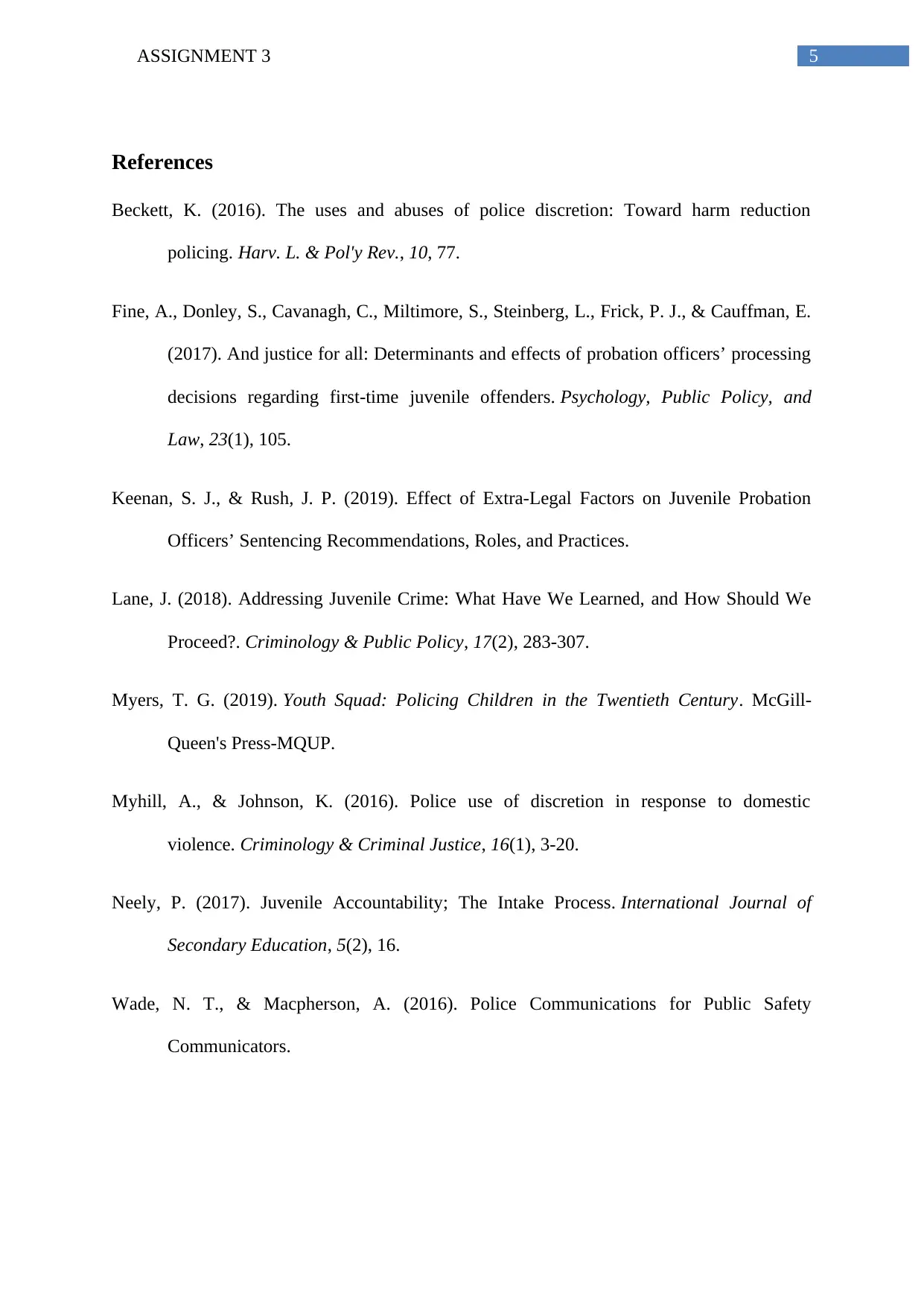Assignment 3: Police Discretion, Gang Units, and Intake Processes
VerifiedAdded on 2022/08/09
|6
|1530
|67
Homework Assignment
AI Summary
This assignment explores several key aspects of law enforcement and juvenile justice. It begins by defining situation-based police discretion, examining its use and potential for abuse. The discussion then shifts to youth squads and gang units, outlining their functions in addressing gang-related activities and juvenile crime. The assignment further delves into the juvenile intake process, detailing the roles of intake officers and the steps involved, from complaint to assessment. Finally, it analyzes the legal and extralegal factors that influence decision-making during the intake process, highlighting how these factors impact the outcomes for juvenile offenders. The solution draws on relevant literature to support the analysis of each topic, providing a comprehensive overview of the discussed concepts.

Running head: ASSIGNMENT 3
Assignment 3
Name of the Student:
Name of the University:
Author Note:
Assignment 3
Name of the Student:
Name of the University:
Author Note:
Paraphrase This Document
Need a fresh take? Get an instant paraphrase of this document with our AI Paraphraser

1ASSIGNMENT 3
Chapter 5
1. What is situation based police discretion? How is discretion used and abused?
Police department is the protectors of law and order. They are the ones who are the
first responders of many situations. In most cases, police faces situations where they have to
show discretion based on the situation. The thin line that exists between lawful act and illegal
acts is decided by the way police decides to use their discretion (Myhill & Johnson, 2016).
There are many situations that they have to face when they have to take discretionary
decisions like deciding whether to draw the weapon or to make any arrest. Sometimes a
situation may arise where they need to decide whether to shoot or not or perform search of a
car or house. They might also need to decide whether to assist somebody in certain situations.
The decisions that the police take in these dilemmas are based on considerations of
pros and cons. The thinking and reasoning that the police employ while taking a decision
might be defined as discretion. Many times, policemen face situations alone and sometimes it
may so happen that they cannot call for assistance or back up (Beckett, 2016). For example, a
policeman might see someone speeding thorough the highway and ask him to pull over. The
person does and the police notices that the person has no records and have never filled fine.
In this situation, the police have the discretion to decide whether to fine him or not. He might
decide to fine him as that is what the law says or they might decide to let him go as per his
discretion. The police often abuse discretion when they act out of prejudice or discriminate
on the grounds of race, ethnicity or their mindset. They might take actions that they did not
need in these cases.
Chapter 5
1. What is situation based police discretion? How is discretion used and abused?
Police department is the protectors of law and order. They are the ones who are the
first responders of many situations. In most cases, police faces situations where they have to
show discretion based on the situation. The thin line that exists between lawful act and illegal
acts is decided by the way police decides to use their discretion (Myhill & Johnson, 2016).
There are many situations that they have to face when they have to take discretionary
decisions like deciding whether to draw the weapon or to make any arrest. Sometimes a
situation may arise where they need to decide whether to shoot or not or perform search of a
car or house. They might also need to decide whether to assist somebody in certain situations.
The decisions that the police take in these dilemmas are based on considerations of
pros and cons. The thinking and reasoning that the police employ while taking a decision
might be defined as discretion. Many times, policemen face situations alone and sometimes it
may so happen that they cannot call for assistance or back up (Beckett, 2016). For example, a
policeman might see someone speeding thorough the highway and ask him to pull over. The
person does and the police notices that the person has no records and have never filled fine.
In this situation, the police have the discretion to decide whether to fine him or not. He might
decide to fine him as that is what the law says or they might decide to let him go as per his
discretion. The police often abuse discretion when they act out of prejudice or discriminate
on the grounds of race, ethnicity or their mindset. They might take actions that they did not
need in these cases.

2ASSIGNMENT 3
2. What are youth squads and gang units? What are their functions?
Gang operations and activities are among the main concerns of the United States Law
Enforcement. Most of the times, the existence of the gangs and gang related violence are
denied of its existence which gives the gang members more impunity to operate freely.
Despite all efforts, gang activities remain one of the most problematic areas for concern and
thus in 1990s the Youth/Gang unit was formed to deal with the issues (Myers, 2019). The
first strategic adoption was done by the Cleveland Police Department and slowly everybody
followed suit. The unit is divided into two squads, one is a youth squad and the other is a
gang squad. These two organs create the whole of the crime related investigations and have
contributed largely in reducing the activities and crimes related to gangs.
The youth squad is responsible for the juvenile crimes and mainly those crimes which
are not related to gang activity or gang violence. They make investigations about the crimes
that happen in their jurisdiction which has no relation to gangs. They take detailed report and
if their investigations find that there are any relations to gang activity, those cases are
transferred to the gang squads (Wade & Macpherson, 2016). The gang squads re responsible
for investigating crimes related to gangs, for both adult and juvenile offenders. They also
investigate misdemeanor crimes as they believe that any kind of information is essential for
the detectives to understand gang operations and the psychology behind it.
Chapter 6
5. What is the intake process? Who performs the intake role? What are the
duties of the intake officer?
An intake process includes the whole journey that starts when a complaint is lodged at
a local law enforcement and ends when the suspect is found not guilty. The officer in charge
2. What are youth squads and gang units? What are their functions?
Gang operations and activities are among the main concerns of the United States Law
Enforcement. Most of the times, the existence of the gangs and gang related violence are
denied of its existence which gives the gang members more impunity to operate freely.
Despite all efforts, gang activities remain one of the most problematic areas for concern and
thus in 1990s the Youth/Gang unit was formed to deal with the issues (Myers, 2019). The
first strategic adoption was done by the Cleveland Police Department and slowly everybody
followed suit. The unit is divided into two squads, one is a youth squad and the other is a
gang squad. These two organs create the whole of the crime related investigations and have
contributed largely in reducing the activities and crimes related to gangs.
The youth squad is responsible for the juvenile crimes and mainly those crimes which
are not related to gang activity or gang violence. They make investigations about the crimes
that happen in their jurisdiction which has no relation to gangs. They take detailed report and
if their investigations find that there are any relations to gang activity, those cases are
transferred to the gang squads (Wade & Macpherson, 2016). The gang squads re responsible
for investigating crimes related to gangs, for both adult and juvenile offenders. They also
investigate misdemeanor crimes as they believe that any kind of information is essential for
the detectives to understand gang operations and the psychology behind it.
Chapter 6
5. What is the intake process? Who performs the intake role? What are the
duties of the intake officer?
An intake process includes the whole journey that starts when a complaint is lodged at
a local law enforcement and ends when the suspect is found not guilty. The officer in charge
⊘ This is a preview!⊘
Do you want full access?
Subscribe today to unlock all pages.

Trusted by 1+ million students worldwide

3ASSIGNMENT 3
of the intake makes all the investigation and tries to decide whether a charge sheet can be
filed. In juvenile intake process, they are taken to a secure care facility where the admission
staff performs the role of intake (Neely, 2017). When the accused arrive at the system, the
staffs record their details. Much of the intake duty is also performed by the Probation and
Parole Officer who provides the staffs with the necessary information about the youth. The
facility searches the youth and his possession and documents the result. They inventory it and
the juvenile is sent to admission.
During the admission, education, medical and mental health staffs are present and
they interview the youth. They evaluate each of them and conduct a detailed assessment of
their educational level, medical conditions and psychological state. They are given treatment
plans and education according to their needs and parents are also encouraged to get involved
in that (Lane, 2018). After a while, the PPO, intake officer, administrative staffs, the youth
and their parents attend sessions where their secure facility is decided. The main concern of
the intake officer is to record everything as honestly as possible and ensure that the youths
receive the correctional facility and education that they need to overcome the barriers that
they have due to conviction.
7. What are several legal and extralegal factors that influence intake decision
making? How do these factors influence intake decision making?
There are several legal and extralegal factors that influence the decision making in the
intake process. The legal factors that influence decision making are the alleged offence and
the kind of information that are available, the kind of crime that the person has committed,
any incriminating or exonerating evidence that is presented for the person and whether the
person has any prior records of crime. The extralegal factors that influence the decision
making includes the attitude of the offender, their educational level and school grades, their
of the intake makes all the investigation and tries to decide whether a charge sheet can be
filed. In juvenile intake process, they are taken to a secure care facility where the admission
staff performs the role of intake (Neely, 2017). When the accused arrive at the system, the
staffs record their details. Much of the intake duty is also performed by the Probation and
Parole Officer who provides the staffs with the necessary information about the youth. The
facility searches the youth and his possession and documents the result. They inventory it and
the juvenile is sent to admission.
During the admission, education, medical and mental health staffs are present and
they interview the youth. They evaluate each of them and conduct a detailed assessment of
their educational level, medical conditions and psychological state. They are given treatment
plans and education according to their needs and parents are also encouraged to get involved
in that (Lane, 2018). After a while, the PPO, intake officer, administrative staffs, the youth
and their parents attend sessions where their secure facility is decided. The main concern of
the intake officer is to record everything as honestly as possible and ensure that the youths
receive the correctional facility and education that they need to overcome the barriers that
they have due to conviction.
7. What are several legal and extralegal factors that influence intake decision
making? How do these factors influence intake decision making?
There are several legal and extralegal factors that influence the decision making in the
intake process. The legal factors that influence decision making are the alleged offence and
the kind of information that are available, the kind of crime that the person has committed,
any incriminating or exonerating evidence that is presented for the person and whether the
person has any prior records of crime. The extralegal factors that influence the decision
making includes the attitude of the offender, their educational level and school grades, their
Paraphrase This Document
Need a fresh take? Get an instant paraphrase of this document with our AI Paraphraser

4ASSIGNMENT 3
standing in school, their gender, their race or ethnicity, involvement of their parents, their
economic status and their age (Keenan & Rush, 2019). All of these factors largely decides the
kind of term or facility that the offender will be sent to.
The legal factors like seriousness of offence or type of crime largely decides the kind
of punishment the offender might receive. For example, any crime where bodily harm or
death has happened is likely to get harsher punishment than other crimes. The intake officer
also consider other aspects such as whether the crime was felony or misdemeanor and
whether the victim acted within a group and many such things. Their intent and potential is
judged in these scenarios. The presence of hard evidence and alibies to decide about the
offender (Fine et al., 2017). They take direct evidence, witness, tangible evidence and
testimonials into account. Extralegal factors affect intake decisions as positive records of
education and lack of prior record often go into the favor of the offender.
standing in school, their gender, their race or ethnicity, involvement of their parents, their
economic status and their age (Keenan & Rush, 2019). All of these factors largely decides the
kind of term or facility that the offender will be sent to.
The legal factors like seriousness of offence or type of crime largely decides the kind
of punishment the offender might receive. For example, any crime where bodily harm or
death has happened is likely to get harsher punishment than other crimes. The intake officer
also consider other aspects such as whether the crime was felony or misdemeanor and
whether the victim acted within a group and many such things. Their intent and potential is
judged in these scenarios. The presence of hard evidence and alibies to decide about the
offender (Fine et al., 2017). They take direct evidence, witness, tangible evidence and
testimonials into account. Extralegal factors affect intake decisions as positive records of
education and lack of prior record often go into the favor of the offender.

5ASSIGNMENT 3
References
Beckett, K. (2016). The uses and abuses of police discretion: Toward harm reduction
policing. Harv. L. & Pol'y Rev., 10, 77.
Fine, A., Donley, S., Cavanagh, C., Miltimore, S., Steinberg, L., Frick, P. J., & Cauffman, E.
(2017). And justice for all: Determinants and effects of probation officers’ processing
decisions regarding first-time juvenile offenders. Psychology, Public Policy, and
Law, 23(1), 105.
Keenan, S. J., & Rush, J. P. (2019). Effect of Extra-Legal Factors on Juvenile Probation
Officers’ Sentencing Recommendations, Roles, and Practices.
Lane, J. (2018). Addressing Juvenile Crime: What Have We Learned, and How Should We
Proceed?. Criminology & Public Policy, 17(2), 283-307.
Myers, T. G. (2019). Youth Squad: Policing Children in the Twentieth Century. McGill-
Queen's Press-MQUP.
Myhill, A., & Johnson, K. (2016). Police use of discretion in response to domestic
violence. Criminology & Criminal Justice, 16(1), 3-20.
Neely, P. (2017). Juvenile Accountability; The Intake Process. International Journal of
Secondary Education, 5(2), 16.
Wade, N. T., & Macpherson, A. (2016). Police Communications for Public Safety
Communicators.
References
Beckett, K. (2016). The uses and abuses of police discretion: Toward harm reduction
policing. Harv. L. & Pol'y Rev., 10, 77.
Fine, A., Donley, S., Cavanagh, C., Miltimore, S., Steinberg, L., Frick, P. J., & Cauffman, E.
(2017). And justice for all: Determinants and effects of probation officers’ processing
decisions regarding first-time juvenile offenders. Psychology, Public Policy, and
Law, 23(1), 105.
Keenan, S. J., & Rush, J. P. (2019). Effect of Extra-Legal Factors on Juvenile Probation
Officers’ Sentencing Recommendations, Roles, and Practices.
Lane, J. (2018). Addressing Juvenile Crime: What Have We Learned, and How Should We
Proceed?. Criminology & Public Policy, 17(2), 283-307.
Myers, T. G. (2019). Youth Squad: Policing Children in the Twentieth Century. McGill-
Queen's Press-MQUP.
Myhill, A., & Johnson, K. (2016). Police use of discretion in response to domestic
violence. Criminology & Criminal Justice, 16(1), 3-20.
Neely, P. (2017). Juvenile Accountability; The Intake Process. International Journal of
Secondary Education, 5(2), 16.
Wade, N. T., & Macpherson, A. (2016). Police Communications for Public Safety
Communicators.
⊘ This is a preview!⊘
Do you want full access?
Subscribe today to unlock all pages.

Trusted by 1+ million students worldwide
1 out of 6
Related Documents
Your All-in-One AI-Powered Toolkit for Academic Success.
+13062052269
info@desklib.com
Available 24*7 on WhatsApp / Email
![[object Object]](/_next/static/media/star-bottom.7253800d.svg)
Unlock your academic potential
Copyright © 2020–2025 A2Z Services. All Rights Reserved. Developed and managed by ZUCOL.





